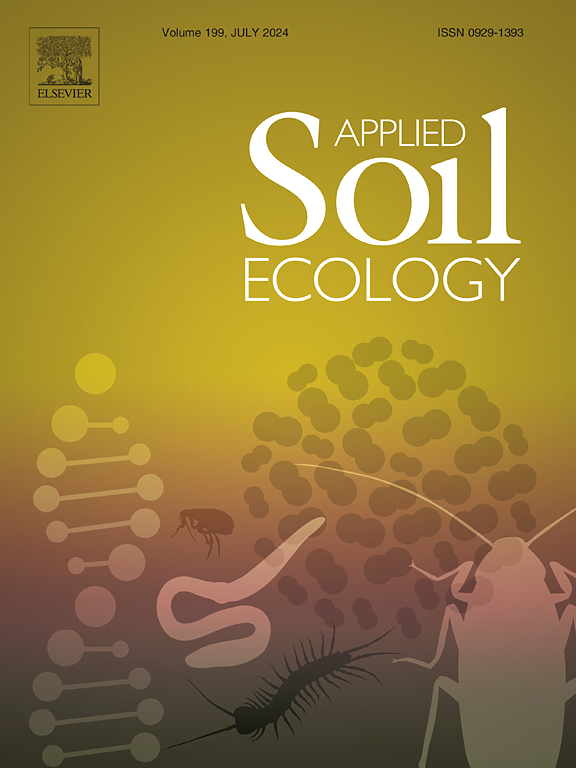Hotspot enlargement and shortening hot moments in the rhizosphere to acquire labile phosphorus from fungal necromass in response to warming effects
IF 4.8
2区 农林科学
Q1 SOIL SCIENCE
引用次数: 0
Abstract
Fungal necromass is a potential energy and nutrient source for microorganisms and plants, yet the elevated temperature accelerates turnover rate of this source while enhances plant nutrient demand. However, a critical question that remains inadequately addressed is whether fungal necromass can be utilized to offset the effects of warming on plant nutrient demand, helping to sustain plant growth in changing climates. In this study, two maize varieties, including a wild-type and root-hair-defective rth3 mutant, were grown in phosphorus (P) deficient soil at temperatures of 20 °C and 30 °C to detect the mechanisms driving the fungal necromass turnover under warming effects and plant root genotypes. By applying in situ zymography, we observed that the percentage of hotspot area in the rhizosphere increases by 65–82 % with a 10 °C temperature rise. However, when fungal necromass was introduced to the soil, the hotspot percentage at 20 °C was 44–116 % higher compared to 30 °C. Additionally, the addition of necromass significantly enlarged the hotspot percentage as compared to zero necromass treatment, particularly at 20 °C. The shorter turnover time of soil organic matter (SOM) at 30 °C compared to 20 °C, following the addition of fungal necromass, clearly indicated that the combined effects of warming and added necromass-derived C and P compounds accelerated SOM decomposition. The formation of a fish-bone root structure in the maize mutant could be a compensatory strategy in response to the absence of root hairs under warming conditions. These fish-bone roots potentially enhanced the acquisition of labile C and P from the added fungal necromass. Furthermore, the unchanged Km but increased Vmax in necromass-treated soil under 30 °C suggested that microorganisms allocate their energy resources to synthesizing more enzymes rather than increasing enzyme efficiency in response to warming stress. Overall, as an easily decomposed substances, fungal necromass mediates the response of the dynamic interactions between plants and microorganisms to rising temperature by enlarging the hotspot percentage by 88 % but shortening duration of organic matter decomposition up to 125 %. Therefore, these processes can be considered as the adaptation of agro-ecosystems to global warming.
为应对气候变暖效应,扩大根瘤菌圈的热点并缩短热点时刻,以便从真菌坏死物中获取可溶性磷
真菌腐质是微生物和植物的潜在能量和营养源,然而温度升高会加快这一来源的周转速度,同时增加植物对营养的需求。然而,一个仍未得到充分解决的关键问题是,能否利用真菌新菌体来抵消气候变暖对植物养分需求的影响,从而帮助植物在不断变化的气候中维持生长。在这项研究中,两个玉米品种(包括野生型和根毛缺陷rth3突变体)分别在20 °C和30 °C的缺磷土壤中生长,以检测气候变暖效应和植物根系基因型下真菌坏死物质周转的驱动机制。通过原位酶谱分析,我们观察到温度上升 10 °C,根瘤菌圈中热点区域的百分比会增加 65-82%。然而,在土壤中加入真菌新菌体后,20 °C时的热点面积百分比比30 °C时高44-116%。此外,与零新菌体处理相比,添加新菌体能显著提高热点百分比,尤其是在 20 °C 时。添加真菌新菌体后,30 °C下土壤有机质(SOM)的周转时间比20 °C下更短,这清楚地表明,在升温和添加新菌体衍生的C和P化合物的共同作用下,SOM的分解速度加快。玉米突变体中鱼骨状根结构的形成可能是对升温条件下根毛缺失的一种补偿策略。这些鱼骨根可能增强了从添加的真菌新菌体中获取可溶性碳和钾的能力。此外,在 30 °C条件下,经坏死物质处理的土壤中的Km不变,但Vmax增加,这表明微生物将其能量资源用于合成更多的酶,而不是提高酶的效率,以应对变暖的压力。总之,真菌新菌体作为一种易分解物质,通过将热点百分比扩大 88%,但将有机物分解持续时间缩短 125%,调解了植物和微生物之间的动态相互作用对温度升高的响应。因此,这些过程可被视为农业生态系统对全球变暖的适应。
本文章由计算机程序翻译,如有差异,请以英文原文为准。
求助全文
约1分钟内获得全文
求助全文
来源期刊

Applied Soil Ecology
农林科学-土壤科学
CiteScore
9.70
自引率
4.20%
发文量
363
审稿时长
5.3 months
期刊介绍:
Applied Soil Ecology addresses the role of soil organisms and their interactions in relation to: sustainability and productivity, nutrient cycling and other soil processes, the maintenance of soil functions, the impact of human activities on soil ecosystems and bio(techno)logical control of soil-inhabiting pests, diseases and weeds.
 求助内容:
求助内容: 应助结果提醒方式:
应助结果提醒方式:


